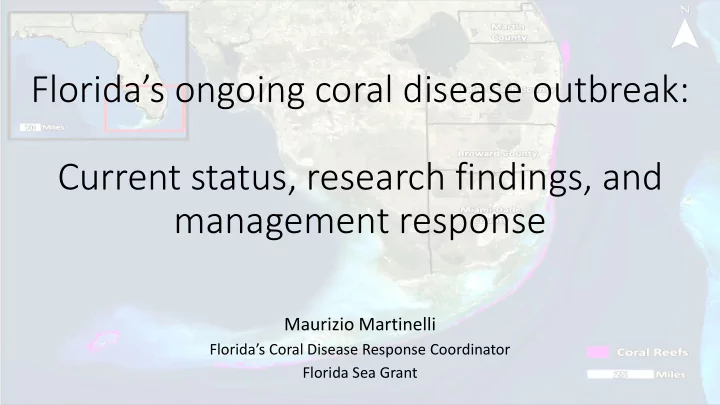

Florida’s ongoing coral disease outbreak: Current status, research findings, and management response Maurizio Martinelli Florida’s Coral Disease Response Coordinator Florida Sea Grant
Photos: FDEP
First signs of trouble Diploria labyrinthiformis Pseudodiploria strigosa Dichocoenia stokesii Eusmilia fastigiata Meandrina meandrites Photos: Rob Ruzicka, FWC
We will cover… The current extent and impact of the coral disease outbreak Key research findings and the management response Resources for you Karen Neely, NSU
= Potential signs of SCTLD
Susceptible species ( = ESA listed species) ( = major framework builders) Intermediately susceptible Highly susceptible Colpophyllia natans (Boulder brain coral) Montastraea cavernosa (Great star coral) Dendrogyra cylindrus (Pillar coral) Orbicella annularis (Lobed star coral) Dichocoenia stokesii (Elliptical star coral) Orbicella faveolata (Mountainous star coral) Diploria labyrinthiformis (Grooved brain coral) Orbicella franksi (Boulder star coral) Eusmilia fastigiata (Smooth flower coral) Siderastrea radians (Lesser starlet coral) Meandrina meandrites (Maze coral) Siderastrea siderea (Massive starlet coral) Pseudodiploria strigosa (Symmetrical brain coral) Solenastrea bournoni (Smooth star coral) Pseudodiploria clivosa (Knobby brain coral) Stephanocoenia intersepta (Blushing star coral) Unknown susceptibility Agaricia agaricites (Lettuce coral) Helioseris cucullata (Sunray lettuce) Mussa angulosa (Spiny flower coral) Agaricia fragilis (Fragile saucer coral) Isophyllia rigida (Rough star coral) Mycetophyllia spp. (Cactus corals) Favia fragum (Golfball coral) Isophyllia sinuosa (Sinuous cactus) Scolymia spp. (Disk corals) Madracis arenterna (Pencil coral)
Rate of tissue loss Highly susceptible species: Tissue loss of 20-40 cm 2 per day Intermediately susceptible: Tissue loss of 5-10 cm 2 per day Dec 2015 Sept 2015 Top: Rob Ruzicka, FWC; Bot: FDEP & NSU
Species-specific prevalence rate 66-100% prevalence of SCTLD on susceptible species
Mortality rate Historically, ~100% mortality rate of colonies showing disease signs Jan 22, 2018 Feb 5, 2018 Feb 16, 2018 March 1, 2018 Top: FDEP; Bot: Sharp & Maxwell, FWC
An unprecedented event? Long tenure. After four years, the disease is still active in endemic areas and advancing through unaffected reefs. Large spatial scale. The outbreak covers most of the reef tract, with no signs of stopping. High number of species affected . Roughly half of Florida’s 45 stony corals are susceptible. High frequency of whole colony mortality. If a colony becomes infected, it will likely suffer complete mortality.
Response Partners
Response Structure Executive Coordination Team (DEP, FWC, NOAA) Disease Response Coordinator Disease Advisory Management Committee Team International Reconnaissance Citizen Restoration Trials Regulatory Team and Intervention Engagement Cooperation Team Team Team Team Epidemiology Data Communications Coral Rescue and Research Management Team Team Team Team
Key research findings Transmission experiments demonstrate this is infectious Therapeutic diagnoses suggest bacterial pathogen(s) are involved Pathogen isolation experimentation has identified pathogenic bacteria Histology suggests that lesions begin in the gastrodermis Temporal progression across species Day 0 Transmission via direct contact and Day 3 through sterile seawater Day 8 Source: Ushijima & Paul, Smithsonian. Unpublished.
Key research findings Transmission experiments demonstrate this is infectious Therapeutic diagnoses suggest bacterial pathogen(s) are involved Pathogen isolation experimentation has identified pathogenic bacteria Histology suggests that lesions begin in the gastrodermis Temporal progression across species No treatment Treated w/ amoxicillin & kanamycin Source: Ushijima & Paul, Smithsonian. Unpublished.
Key research findings Transmission experiments demonstrate this is infectious Therapeutic diagnoses suggest bacterial pathogen(s) are involved Pathogen isolation experimentation has identified pathogenic bacteria Histology suggests that lesions begin in the gastrodermis Temporal progression across species Source: Ushijima et al., Smithsonian. Unpublished.
Key research findings Transmission experiments demonstrate this is infectious Therapeutic diagnoses suggest bacterial pathogen(s) are involved Pathogen isolation experimentation has identified pathogenic bacteria Histology suggests that lesions begin in the gastrodermis Temporal progression across species Source: Landsberg et al., FWC. Unpublished.
Key research findings Transmission experiments demonstrate this is infectious Therapeutic diagnoses suggest bacterial pathogen(s) are involved Pathogen isolation experimentation has identified pathogenic bacteria Histology suggests that lesions begin in the gastrodermis Temporal progression across species Source: Sharp & Maxwell, FWC. Unpublished.
Disease treatments Antiseptic treatment: chlorinated epoxy Antibiotic treatment: amoxicillin via ‘Base2’ or shea butter Top: Brian Walker, NSU; Bot: Karen Neely, NSU
Coral Rescue Collection efforts are underway to “rescue” colonies of priority species ahead of the disease front to be kept in on-land facilities for future restoration efforts Photos: Stephanie Schopmeyer, FWC
What to look for on your reefs A tissue loss disease presenting on multiple species (1) M. meandrites , C. natans , D. cylindrus (2) Other brain corals Sequential disease signs by species (3) Boulder corals Lesions sometimes starting in apparently healthy tissue
Resources Stony Coral Tissue Loss Disease Case Definition Field Identification Guide Coral Disease Treatment SOPs Diver Decontamination Protocol International Coordination Team Florida Reef Tract Coral Disease Coordination Calls Available at: https://floridakeys.noaa.gov/coral-disease/ Karen Neely, NSU https://floridadep.gov/fco/coral/content/florida-reef-tract-coral-disease-outbreak
Maurizio Martinelli Coral Disease Response Coordinator +1 305 795 1221 mmartinelli1@ufl.edu https://floridakeys.noaa.gov/coral-disease/ https://floridadep.gov/fco/coral/content/florida-reef-tract-coral-disease- outbreak
Recommend
More recommend